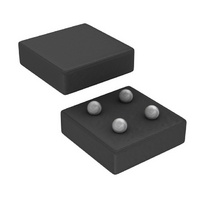LMV1032UP-25/NOPB National Semiconductor, LMV1032UP-25/NOPB Datasheet - Page 8

LMV1032UP-25/NOPB
Manufacturer Part Number
LMV1032UP-25/NOPB
Description
IC AMP AUDIO MONO AB MIC 4USMD
Manufacturer
National Semiconductor
Type
Class ABr
Datasheet
1.LMV1032UPX-06NOPB.pdf
(12 pages)
Specifications of LMV1032UP-25/NOPB
Output Type
1-Channel (Mono)
Voltage - Supply
1.7 V ~ 5 V
Features
Microphone
Mounting Type
Surface Mount
Package / Case
4-MicroSMD
Operational Class
Class-AB
Audio Amplifier Output Configuration
1-Channel Mono
Audio Amplifier Function
Microphone
Total Harmonic Distortion
0.35%
Single Supply Voltage (typ)
3V
Dual Supply Voltage (typ)
Not RequiredV
Supply Current (max)
0.085@5VmA
Power Supply Requirement
Single
Rail/rail I/o Type
No
Power Supply Rejection Ratio
65dB
Single Supply Voltage (min)
1.7V
Single Supply Voltage (max)
5V
Dual Supply Voltage (min)
Not RequiredV
Dual Supply Voltage (max)
Not RequiredV
Operating Temp Range
-40C to 85C
Operating Temperature Classification
Industrial
Mounting
Surface Mount
Pin Count
4
Package Type
uSMD
Lead Free Status / RoHS Status
Lead free / RoHS Compliant
Max Output Power X Channels @ Load
-
Lead Free Status / Rohs Status
Compliant
Other names
LMV1032UP-25
LMV1032UP-25TR
LMV1032UP-25TR
www.national.com
Application Section
LOW CURRENT
The LMV1032 has a low supply current which allows for a
longer battery life. The low supply current of 60µA makes this
amplifier optimal for microphone applications which need to
be always on.
BUILT-IN GAIN
The LMV1032 is offered in the space saving small micro
SMD package which fits perfectly into the metal can of a
microphone. This allows the LMV1032 to be placed on the
PCB inside the microphone.
The bottom side of the PCB has the pins that connect the
supply voltage to the amplifier and make the output avail-
able. The input of the amplifier is connected to the micro-
phone via the PCB.
A-WEIGHTED FILTER
The human ear has a frequency range from 20 Hz to about
20 kHz. Within this range the sensitivity of the human ear is
not equal for each frequency. To approach the hearing re-
sponse weighting filters are introduced. One of those filters
is the A-weighted filter.
The A-weighted filter is usually used in signal-to-noise ratio
measurements, where sound is compared to device noise. It
improves the correlation of the measured data to the signal-
to-noise ratio perceived by the human ear.
FIGURE 2. A-Weighted Filter
FIGURE 1. Built-in Gain
20084209
20084202
8
MEASURING NOISE AND SNR
The overall noise of the LMV1032 is measured within the
frequency band from 10 Hz to 22 kHz using an A-weighted
filter. The input of the LMV1032 is connected to ground with
a 5 pF capacitor.
The signal-to-noise ratio (SNR) is measured with a 1 kHz
input signal of 18 mV
represents a sound pressure level of 94 dB SPL. No input
capacitor is connected.
SOUND PRESSURE LEVEL
The volume of sound applied to a microphone is usually
stated as the pressure level with respect to the threshold of
hearing of the human ear. The sound pressure level (SPL) in
decibels is defined by:
Sound pressure level (dB) = 20 log P
Where,
P
P
In order to be able to calculate the resulting output voltage of
the microphone for a given SPL, the sound pressure in dB
SPL needs to be converted to the absolute sound pressure
in dBPa. This is the sound pressure level in decibels which is
referred to as 1 Pascal (Pa).
m
O
is the threshold of hearing (20µPa)
is the measured sound pressure
FIGURE 3. Noise Measurement Setup
PP
using an A-weighted filter. This
m
/P
O
20084210












